California fivespined ips
Ips paraconfusus
Pine Engraver
Ips pini
Key Wildlife Value:
Pine engraver and California fivespined ips (pine engravers) create pine snags and dead tops in large pines. Although small trees averaging 12.5 to 20 cm (5 to 8 in) dbh are most commonly killed, pine engravers sometimes kill larger trees individually or in groups ranging up to 500 pole-size trees. During outbreaks, I. paraconfusus has been documented killing trees up to 66 cm (26 in) dbh. Their activity in the tops of large pines initiates a succession of organisms and processes that often results in the eventual formation of unique dead wood structures in living trees. Colonized trees and tree tops provide good foraging habitat for woodpeckers. Canopy gaps and high-density snag patches are sometimes created, increasing structural diversity and sometimes resulting in increased compositional diversity of developing stands. Trees killed by pine engravers eventually contribute to levels of down wood when they break or fall over.
Distribution in Oregon and Washington:
I. paraconfusus occurs in Oregon and Washington from the east slopes of the Cascade Mountains to the coast, predominating in regions west of the Cascade Mountains crest and the vicinity of Hood River, OR. I. pini occurs throughout Oregon and Washington, predominating in regions east of the Cascade Mountains crest.
Hosts:
Hosts: Most commonly found in ponderosa, lodgepole, sugar, and Jeffrey pines, but may occur on almost any species of pine
Diagnosis:
Reddish-orange boring dust in small mounds around entrance holes, in bark crevices, and on the ground around slash or fading pine trees can indicate attack by I. pini or I. paraconfusus.
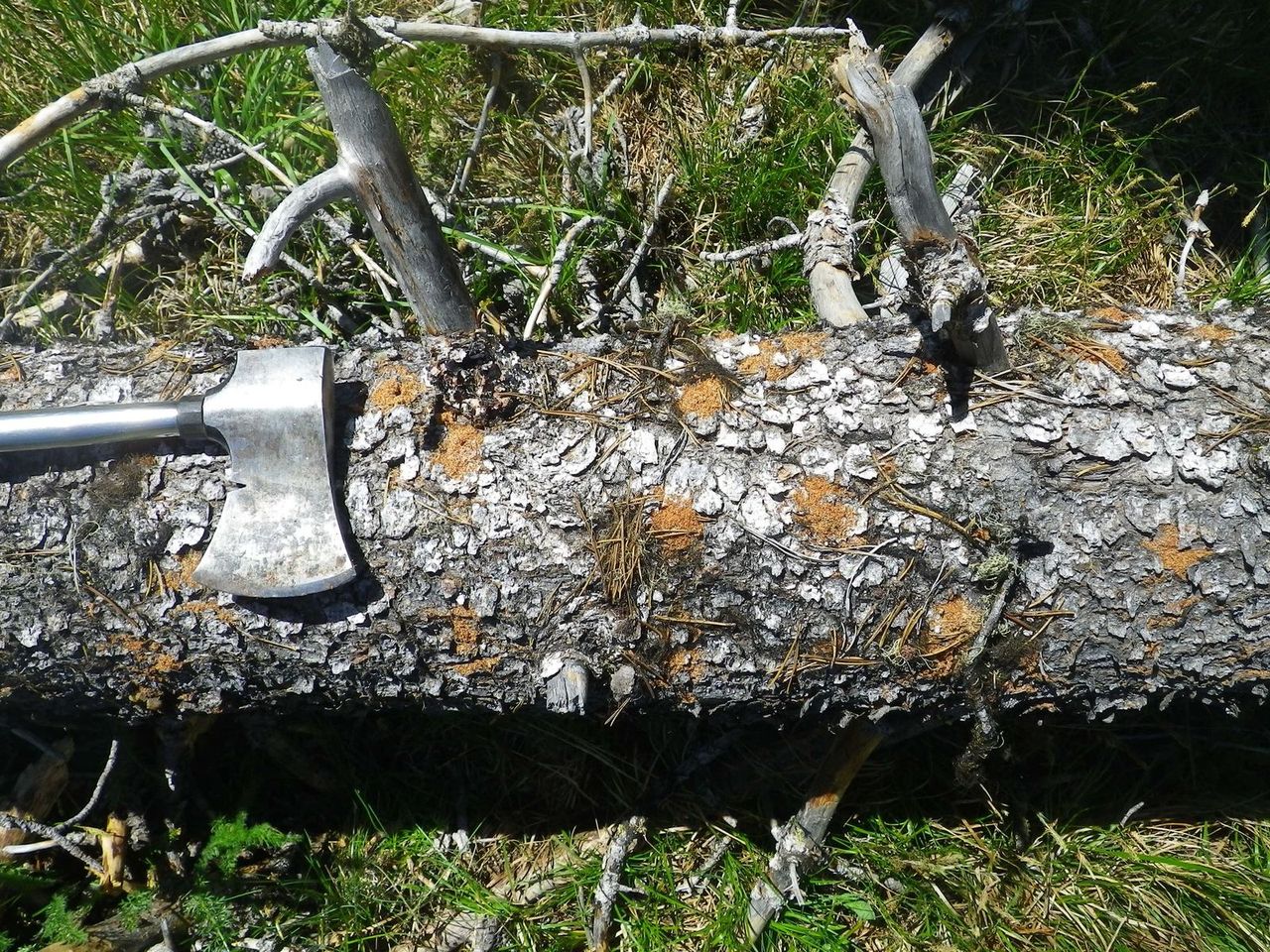
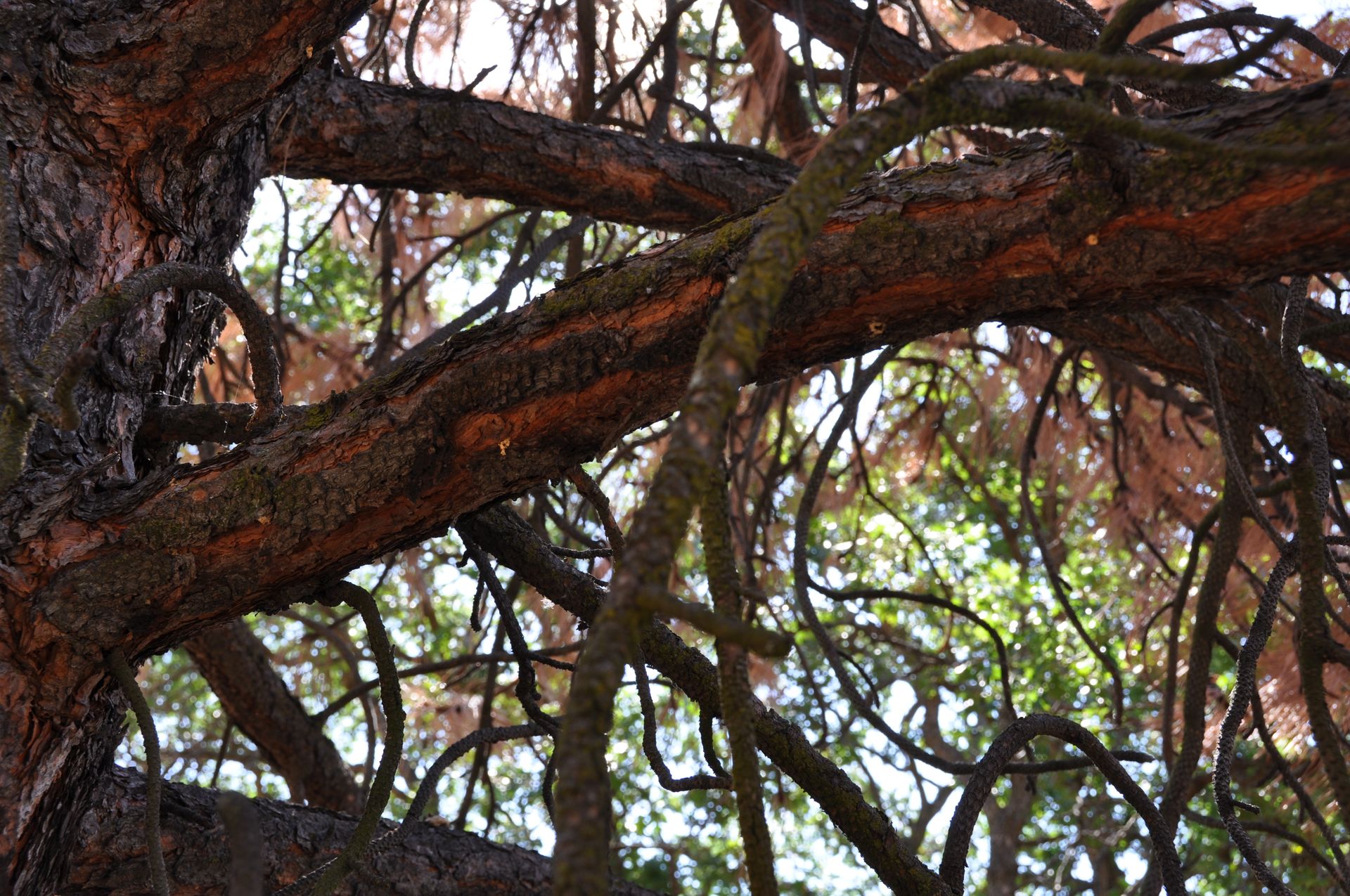
Diagnostic gallery patterns will be found under the bark of infested tree boles. Egg galleries etch the sapwood surface, are free of frass and usually longitudinal, with total lengths of 10 to 25 cm (4 to 10 in). The overall pattern may be somewhat variable, appearing as Y-, H-, or star-shaped, and with a centrally located nuptial chamber. Larval galleries are packed with frass and extend laterally 2.5 to 5.0 cm (1 to 2 in) from the egg galleries. Mazelike feeding galleries lightly etched onto the sapwood surface also may be evident, sometimes obscuring the egg gallery patterns.
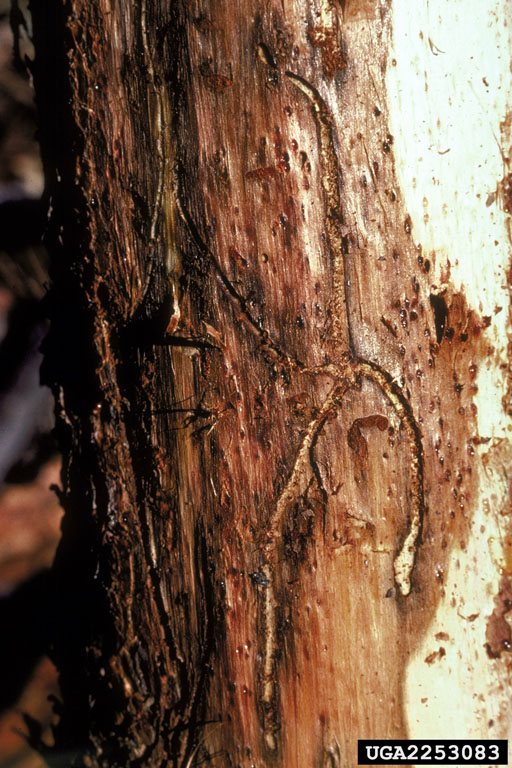
Larvae are white legless grubs with brown heads. Pupae are white and soft, with body forms somewhat resembling adults. Adult beetles are cylindrical with clubbed antennae, dark red-brown to black, and about 4 mm long. A dish-shaped depression with four (I. pini) or five (I. paraconfusus) spines along each side is located on the posterior end of the wing covers.

Three mortality patterns are typical and their consideration may aid diagnosis: 1) endemic, scattered individual mortality of trees stressed by competition, injury, or disease, 2) activity in larger trees causing death of the upper 1/2 to 1/3 of the crown, usually in scattered individuals, and 3) outbreaks in sapling and pole-size pine stands, characterized by grouped mortality and associated with abundant fresh windfall or logging slash.
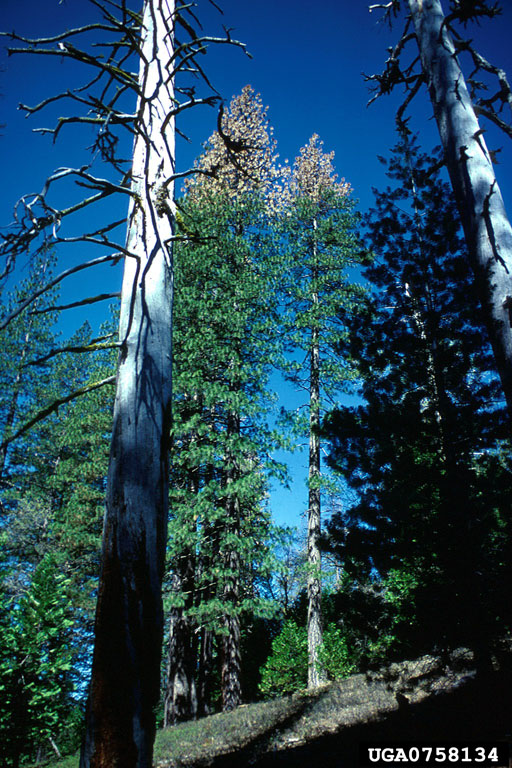
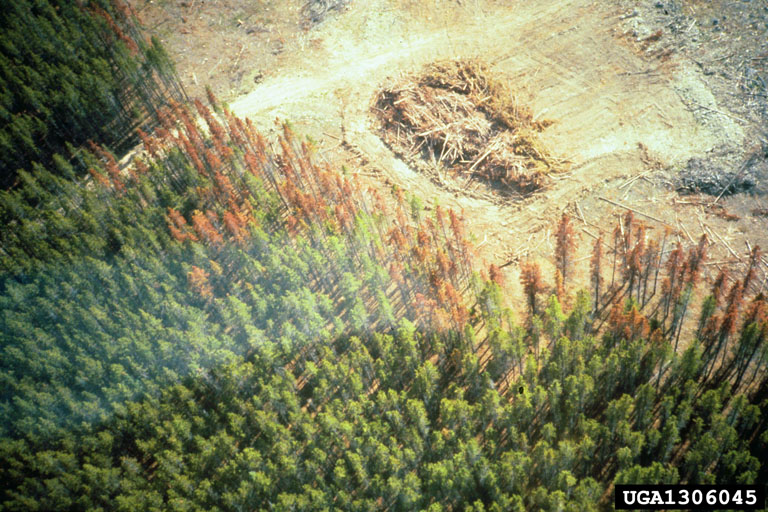
Life History:
Pine engraver and California fivespined ips have two to four generations per year in Oregon and Washington. Two generations per year are normal east of the Cascades crest, while in the milder climate of southwest Oregon, up to four generations per year may occur. There are four life stages: egg, larva, pupa, and adult.
Beetles emerge from their overwintering sites in spring when daily maximum temperatures reach 15 to 21° C. Males bore through the bark of fresh down material or severely weakened trees to construct nuptial chambers. They emit a pheromone that attracts females and other males, and usually mate with three to four females. Each mated female constructs an egg gallery beginning in the nuptial chamber, excavating outward parallel with the grain of the wood and depositing her eggs in niches along the sides. Frass is pushed out the original entrance holes to keep the galleries clear for movement, and accumulates on the boles and at the bases of the trees until scattered by wind or rain. After hatching, larvae bore away from the egg galleries, feeding in the phloem until they complete their development. Pupation occurs in oval pupal cells, and adults emerge about six to eight weeks after initial attack. This cycle is repeated one to three times more through the remainder of the season. If additional suitable material is not available in midsummer when the progeny of the first brood emerges, beetles will attack standing trees. Broods develop most successfully in shaded slash and on the undersides of cut logs, where bark moisture remains favorable throughout development. Pine engraver adults sometimes congregate in large groups under the bark of standing trees in late summer, where they feed on inner bark, nearly obliterating any egg gallery patterns. The winter is spent under the bark of trees and slash or under duff and litter on the forest floor. Pine engravers overwinter mostly as adults, and California fivespined ips spend the winter as mature larvae, pupae and adults. Populations emerging in the spring are usually small, because overwintering populations usually experience high levels of mortality.
Like the mountain pine beetle, pine engravers introduce a blue-stain fungus that helps them overcome tree defenses. Other bark beetles, including mountain pine beetle, Jeffrey pine beetle, and western pine beetle, often attack and kill large pine trees with tops colonized or killed by I. pini or I. paraconfusus.
Important habitats and outbreak dynamics:
I.pini is the primary Ips species in Eastside ponderosa and lodgepole pine. I. paraconfusus predominates in ponderosa pine on the Westside. Aside from location, important habitats and outbreak dynamics are very similar between the two species. Fresh down pine material and trees under stress from overcrowding, injury, drought, or disease provide important habitat. Fresh down material greater than 7.6 cm (3 in), in particular, provides optimum habitat for colonization and brood production, and is especially important habitat in the spring and early summer when standing trees tend to still have adequate moisture and are more resistant to beetle attack. Both Ips species prefer thin-barked (0.3 to 2.5 cm, or 1/8 to 1 in, thickness), small-diameter portions of live stems, or recently cut or weather-damaged host material. They commonly colonize green slash of any diameter, small trees 5 to 25 cm (2 to 10 in) in diameter, and the thin-barked tops of larger trees. Pine engravers frequently attack the tops of trees colonized by western pine beetle or mountain pine beetle. Conversely, trees topkilled by pine engravers are frequently attacked and killed by other bark beetle and wood borer species, including western pine beetle and mountain pine beetle. During prolonged outbreaks, entire large trees sometimes are successfully colonized and killed by successive generations of Ips paraconfusus.
When populations are low, scattered individuals and groups of usually 10 trees or less are colonized. Attacked trees frequently are injured, diseased, or suppressed. Outbreaks can be initiated by human activities (most commonly by thinning operations in sapling and pole-size pine stands) or by drought. Outbreaks usually last no more than one year, due to high mortality of overwintering beetles, but may last as long as 6 or 7 years during prolonged drought or with the right mix of sequential disturbance events. One-year outbreaks are seldom detected until after most mortality has already occurred. Outbreaks usually occur when precipitation during the months of April through July is 75 percent of normal or less. During such years, overstocked stands of sapling and pole-size ponderosa pine are especially susceptible to attack, and the tops of large ponderosa pine trees are frequently killed. Old records indicate that about 50 percent of recently topkilled ponderosa pine are attacked on the main bole by the western pine beetle within a few years. The remaining 50 percent may survive for long periods as stag-topped trees. Trees in overstocked young stands are often killed in large clumps of 50 to 500 individuals. Due to their sporadic nature and short duration, the effects of pine engraver outbreaks on stands over time usually is not one of thinning, but of sporadic aggregated mortality. Outbreaks in thinned stands of sapling and pole-size ponderosa and lodgepole pine may occur when fresh slash is available to adults emerging from their overwintering locations during spring and early summer. Populations increase rapidly in the down material, then later generations move into nearby healthy standing trees in midsummer as the trees begin experiencing moisture stress. Such outbreaks are especially likely to occur during warm, dry years.
Opportunities for Manipulation to Increase Wildlife Habitat:
It may be possible to create groups of small-diameter snags in even-age, sapling and pole-size ponderosa or lodgepole pine stands deficient in dead wood by baiting trees with pheromone attractants or by creating or retaining limited numbers of slash piles having green material larger than 7.6 cm (3 in), and piling them around the bases of trees in areas selected for snag creation. Habitat for animals that utilize concentrations of dead wood would be increased as well. However, use of these methods would be largely experimental, and it is unknown to what degree they could reliably achieve desired outcomes.
Potential Adverse Effects:
Outbreaks during droughty periods may cause extensive and undesired levels of mortality in areas with overstocked sapling and pole-size ponderosa pine or in areas where host pines occupy harsh, marginal sites. Outbreaks associated with thinning slash may result in the death of large numbers of residual trees, requiring additional expenditures to meet management objectives for stocking and cover.
How to Minimize the Risk of Adverse Effects:
Vigorous, fast growing stands are the most effective deterrent to mitigate the effects of drought-induced outbreaks of pine engraver and California fivespined ips. Keeping sapling and pole-size stand thinned so trees maintain optimum growth will help to minimize the adverse effects of such outbreaks. Stands thinned to basal areas of 80 to 100 square feet per acre have been found to be less susceptible to beetle attack.
Tree mortality following thinning operations may be minimized by adhering to the following guidelines:
- Do not create green slash with diameters greater than 7.6 cm (3 in) during January through July. Down material less than 7.6 cm (3 in) may be created at any time because it dries out rapidly, and these beetles avoid breeding in partially dried or dried slash.
- Scatter slash in openings away from shade to encourage rapid drying. Slash piles result in shading that slows the drying process and maintains favorable habitat.
- Keep slash at least several yards away from the boles of standing trees. If enough beetles are attracted to slash near trees, adjacent trees may be killed.
When larger slash is created during January through July, the following techniques may be used to prevent excessive tree mortality:
- Reduce the amount of suitable breeding material before August by chipping fresh slash, or by trampling slash with heavy machinery to break it into small pieces and then scattering it in open areas. The use of heavy equipment in this manner, however, should be carefully prescribed to prevent adverse effects upon soil structure and future stand health.
- When thinning large areas, a technique called the “green-chain” may be employed. Thinning, which may begin as early as January, is timed so that new slash is being either continuously created or created at 2-week intervals during July and August. Because fresh slash is more attractive to pini or I. paraconfusus than standing trees, this continuous supply of slash absorbs beetles as they emerge from slash created during January through June.
- Another technique that may be employed when thinning large areas is to create very large piles of slash, at least 3.3 m (10 ft) high and 3.3 m (10 ft) long, spaced in thinning units at distances no more than 0.4 km (1/4 mi) apart. The slash in the interiors of these piles is plentiful and remains shaded and attractive to the beetles during the summer months, luring them away from attacking nearby trees.
During prolonged periods of drought even the most careful slash management techniques may not be effective. In such circumstances, it is best to delay stand treatment activities until normal moisture patterns have returned.
References
Goheen, E.M. and E.A. Willhite. 2006. Field guide to common diseases and insect pests of Oregon and Washington conifers. USDA Forest Service, Pacific Northwest Region, Portland, OR. R6-NR-FID-PR-01-06. 335 pp. http://www.biodiversitylibrary.org/bibliography/80321#/summary
Furniss, R.L., and Carolin, V.M. 1977. Western forest insects. USDA Forest Service, Washington, D.C. Misc. Publ. 1339. 654 pp.
Kegley, S.J., R.L. Livingston, and K.E. Gibson. 1997. Pine engraver, Ips pini (Say), in the western United States. USDA Forest Service, Pest Leaflet 122. 5 pp.
Miller, J.M., and F.P. Keen. 1960. Biology and control of the western pine beetle. USDA Forest Service Misc. Publ. No. 800. 381 pp.
Schultz, D.E., and W.D. Bedard. 1987. California fivespined ips. USDA Forest Service, Forest Insect and Disease Leaflet 102. 8 pp.
Website links
Western Forest Insects and Diseases: Publications and Links
Forest Insect and Disease Leaflets - California Fivespined Ips